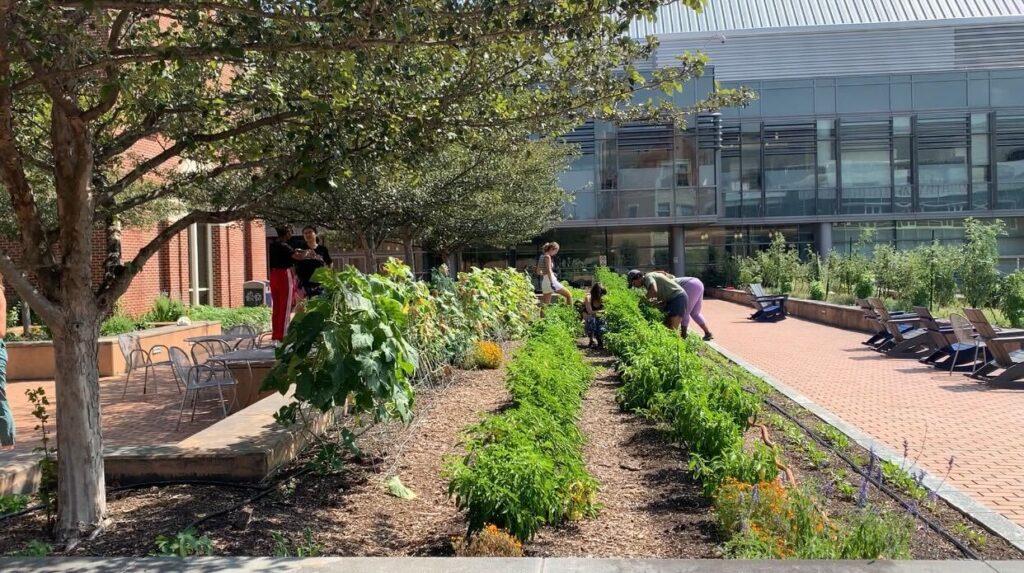The Earth Commons Institute celebrated the start of a new season for the Hoya Harvest Garden, located on the outdoor patio of Regents Hall, at their Welcome Back Planting Party Aug. 27.
The event, led by Earth Commons post-baccalaureate fellow Shelby Gresch (SFS ’22) along with student gardeners Abby Rich (SFS ’25) and Charlotte Correiro (CAS ’24), offered community members a chance for hands-on involvement, with volunteers helping weed plant beds and plant seedlings, among other gardening tasks.
The Welcome Back Planting Party also invited dozens of students to learn about the garden’s mission and achievements, enjoy the beautiful outdoor space during a group yoga class and connect with others interested in environmental sustainability.
Gresch, who has spearheaded plans for the Hoya Harvest Garden since 2022, reiterated the garden’s mission of sparking on-campus conversations about the intersection of food and the environment.
“Food is one of the most fundamental ways that everyone connects with the environment, but increasingly, it is also one of the most destructive industries,” Gresch said at the event. “The garden is a way to get us thinking about that, while also beautifying space on campus, building community and providing food for the community.”

Gresch said the food industry accounts for over a quarter of the world’s greenhouse gas emissions, also citing habitat loss, deforestation and land use change — the conversion of biodiverse ecosystems to farmland — as environmentally harmful consequences of food production.
In addition to raising awareness about sustainable food systems, the garden has also been able to provide healthy, locally harvested produce to people experiencing food insecurity, which climate change will continue to exacerbate in coming years.
“The food grown in the garden goes to either the Hoya Hub, which is the food pantry on campus, or the Father McKenna Center, which is a Jesuit-run day center in downtown Washington, D.C. for folks experiencing homelessness,” Gresch said. “Or, some of it — the basil and the leafy greens — we sell to Leo’s.”
This summer, the garden celebrated its first-ever summer harvest, thanks to the hard work of Gresch, Rich and Correiro. They worked full-time in the garden, despite record-breaking temperatures, weeding, watering, harvesting and delivering produce.
“The heat was a big challenge,” Correiro told the Hoya. “We were turning over all of these beds, removing and excavating since July. In the future, summer would not be the time to do that.”
This semester, the Hoya Harvest Garden will expand its planting area to recently-acquired soil beds located next to the Rafik B. Hariri Building. The Welcome Back Planting Party aimed to engage more student volunteers to tend to these new rows of plants, which will feature peas, broccoli, lettuce, beets and bok choy.
“This almost doubles the size of our space, with the addition of these three beds,” Correiro said.
Correiro hopes that an increase in academic and community engagement with the Hoya Harvest Garden will accompany its physical expansion.
“In the spring, the garden wasn’t as visible; we just didn’t have that much stuff growing,” Correiro said. “Hopefully, now that it’s more visible, students and faculty will be more interested in doing more.”
Peter Marra, the dean of the Earth Commons, said that although it is primarily an educational initiative, the garden has also yielded several hearty crops of produce since its opening in April.
“It’s an important demonstration garden, but it has also produced over 5,000 servings of food — 1,000 pounds of vegetables from just these beds,” Marra told The Hoya.
Indeed, Marra said that many faculty members have already incorporated the Hoya Harvest garden into their curricula. In the Environmental Studies department, for example, students in professor Leah Buchman’s course entitled “Bugs & Fungus Among Us” will conduct insect surveys in the garden.
Marra envisions the garden as a “living lab” that students and faculty can use to incorporate ideas about food production and sustainability into their classes as well as their daily lives.
“This is a place where students are living, acting, eating,” Marra said. “That’s the whole point of a living lab, you’re studying it but also participating in it.’.
The success of the Welcome Back Planting Party certainly highlighted the garden’s social value, in addition to its usefulness as a teaching tool. Marra hopes that the garden will serve as a community hub for those interested in sustainable food systems, as well as anyone seeking to enjoy the garden’s beauty.
“I am ecstatic over how this has brought people together,” Marra said, “I think as we do more of these events in the garden, they will continue to galvanize the community to make everyone more understanding and thoughtful about food and where it comes from.”









